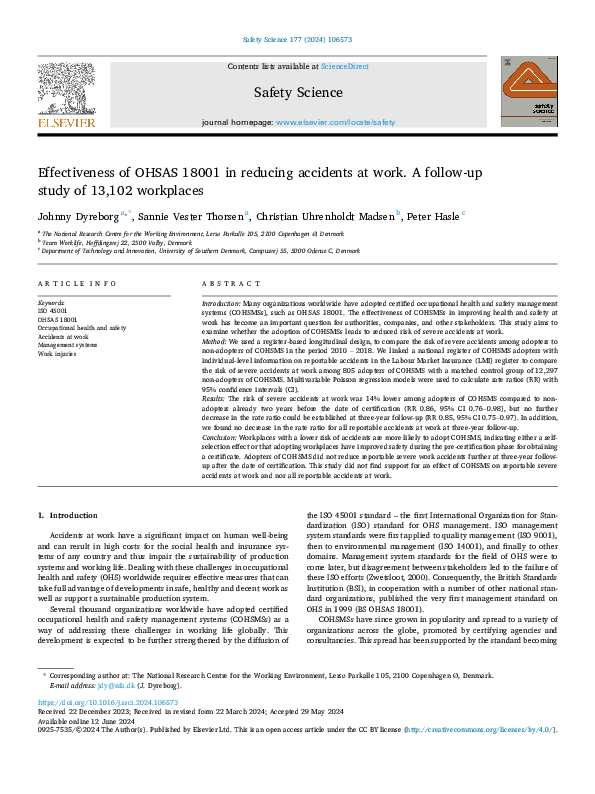Effectiveness of OHSAS 18001 in reducing accidents at work: a follow-up study of 13,102 workplaces

Dyreborg, Johnny ; Vester Thorsen, Sannie ; Uhrenholdt Madsen, Christian ; Hasle, Peter
2024
177
106573
occupational accidents ; analysis of accident causes ; standard ; implementation ; case study
Occupational accidents
https://doi.org/10.1016/j.ssci.2024.106573
English
Bibliogr.;Statistics
"Introduction
Many organizations worldwide have adopted certified occupational health and safety management systems (COHSMSs), such as OHSAS 18001. The effectiveness of COHSMSs in improving health and safety at work has become an important question for authorities, companies, and other stakeholders. This study aims to examine whether the adoption of COHSMSs leads to reduced risk of severe accidents at work.
Method
We used a register-based longitudinal design, to compare the risk of severe accidents among adopters to non-adopters of COHSMS in the period 2010 – 2018. We linked a national register of COHSMS adopters with individual-level information on reportable accidents in the Labour Market Insurance (LMI) register to compare the risk of severe accidents at work among 805 adopters of COHSMS with a matched control group of 12,297 non-adopters of COHSMS. Multivariable Poisson regression models were used to calculate rate ratios (RR) with 95% confidence intervals (CI).
Results
The risk of severe accidents at work was 14% lower among adopters of COHSMS compared to non-adopters already two years before the date of certification (RR 0.86, 95% CI 0.76–0.98), but no further decrease in the rate ratio could be established at three-year follow-up (RR 0.85, 95% CI 0.75–0.97). In addition, we found no decrease in the rate ratio for all reportable accidents at work at three-year follow-up.
Conclusion
Workplaces with a lower risk of accidents are more likely to adopt COHSMS, indicating either a self-selection effect or that adopting workplaces have improved safety during the pre-certification phase for obtaining a certificate. Adopters of COHSMS did not reduce reportable severe work accidents further at three-year follow-up after the date of certification. This study did not find support for an effect of COHSMS on reportable severe accidents at work and nor all reportable accidents at work."
Digital
The ETUI is co-funded by the European Union. Views and opinions expressed are however those of the author(s) only and do not necessarily reflect those of the European Union or the ETUI.